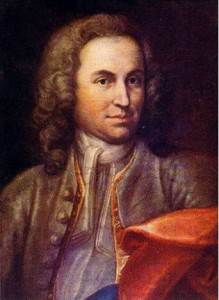
The Young Johann Sebastian Bach, painted in 1715 by J. E. Rentsch, the Elder
Just a day like today, 266 years ago, a man passed away at 65 while sleeping. Nowadays, this man is considered to be the musician of all musicians, the composer of all composers: Johann Sebastian Bach (1685-1750). He died as a result of an infection caused by a cataracts operation performed by an infamous English oculist and surgeon called John Taylor (1703-1772) – Samuel Johnson (1709-1784) set him as an example of “how far imprudence may carry ignorance”. It’s also quite interesting to know that German born George Friedrich Handel (1685-1759) also died because of the same eye operation by the same “surgeon” nine years after Bach’s death. By the way, all that these two composers have in common is their year of birth, 1685 (also the year of birth of yet another great composer, Domenico Scarlatti) and that they were killed by the same person. Bach and Handel never met. Handel enjoyed fame and success as a composer in his life time. Bach did not. Bach was not even considered as a second-line composer. He did enjoy, however, fame and high reputation as the best organist of his time, but his composition style was considered old-fashioned and his works were too difficult to perform by his contemporaries. Actually, after his death, a lot of his works were sold… as wrapping paper!! Yes, yes, a great deal of Bach’s works ended up wrapping food, vegetables and meat. In other words, the paper on which he wrote his scores was way more valued than its contents. Unfortunately, these are works we will never get to know.
Quite a lot of years after Bach’s death, Carl Friedrich Zelter (1758-1832) apparently bought St. Matthew’s Passion at an auction were, guess what was being sold… paper!! Would not have Zelter bought that score, it would have most likely ended up as wrapping paper. It was precisely Zelter who instilled his love for Bach’s music into his disciple Felix Mendelssohn (1809-1847). And 80 years had to go by after Bach’s death until his music was rescued from oblivion for the big audience when Mendelssohn publicly conducted St. Matthew’s Passion himself. The rest is hisory.
Bach’s influence as a composer in Western concert music has been omnipresent and all-embracing ever since. It is a great paradox that someone who had been considered a third or four-line composer in his life time, however, he marked the end of a musical style: the baroque. It is usually said that the baroque ends in 1750, the year Bach died. In reality, the musical baroque ended some 20 or 25 years earlier. If it would not have been for those last 20 years of Bach’s life, some works such as the Mass in b minor, the Goldberg Variations, the Musical Offering and The Art of the Fugue would have never come to light.
For those of you who would like to know a little more about this great man, a relentless worker and a wise musician, here I recommend some links:
- Bach, The Learned Musician by Christoph Wolff. W.W. Norton & Company, 2001.
- Bach, CD by Spanish organist Juan de la Rubia, 2016.
- Bach and the High Baroque by professor Robert Greenberg (an excellent course, by the way. I cannot get tired of recommending it), The Great Courses, 1998.
- Discovering Bach, BBC Radio 3 podcasts (free).
- La hora de Bach (in Spanish and free), presented and directed by Sergio Pagán. Radio Clásica.
By the way, the picture accompanying this article is that of a poster I asked my parents to buy for me when I was 10 or 12 years old. Back then I wanted to become an organist and a musician like Bach. I have not achieved it though…
Today I want to commemorate the day on which the man died and his legend of an immeasurable great legacy was born. I agree with Spanish organist Juan de la Rubia: Bach helps me be a better person.
Michael Thallium
Global & Greatness Coach
Book your coaching here
You can also find me and connect with me on:
Facebook Michael Thallium and Twitter Michael Thallium
